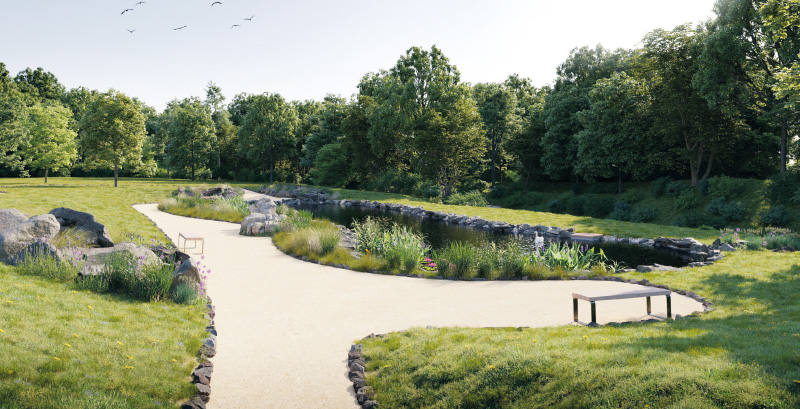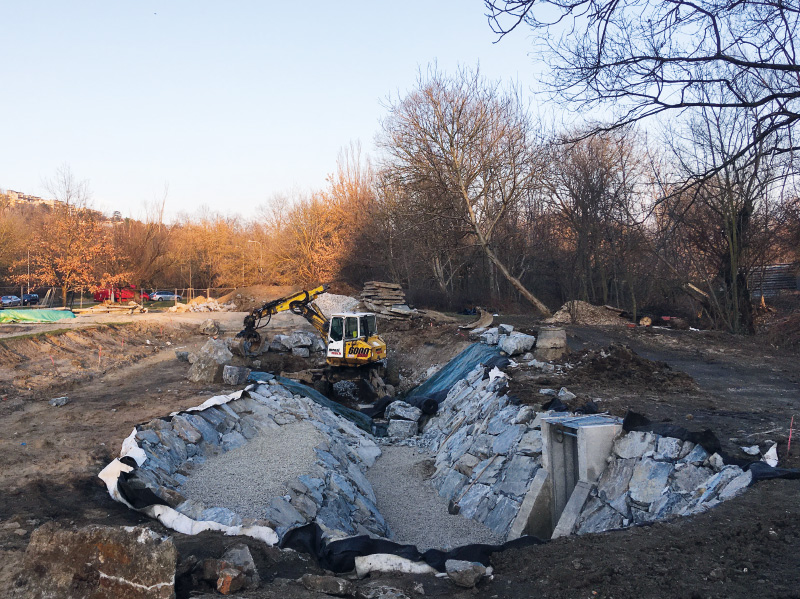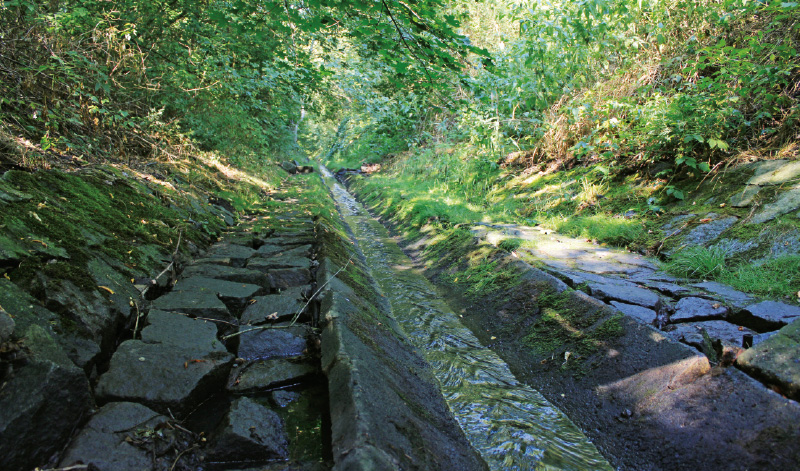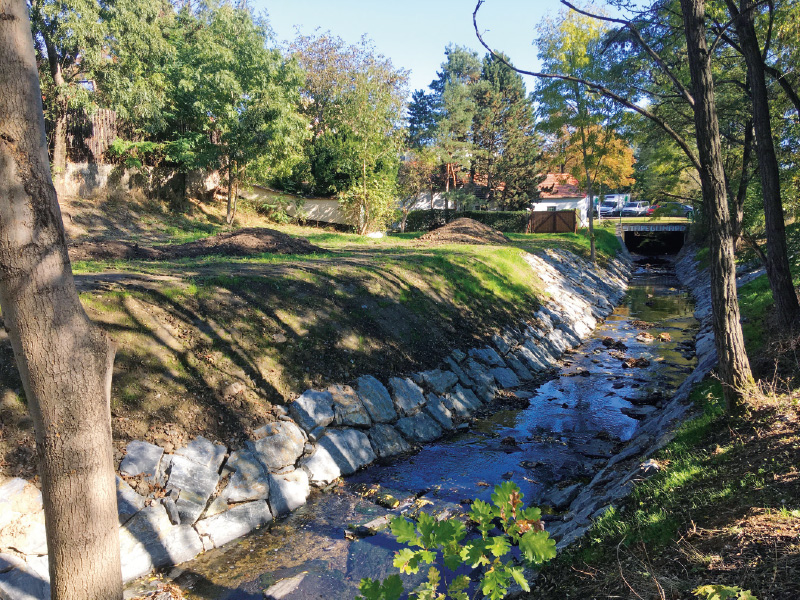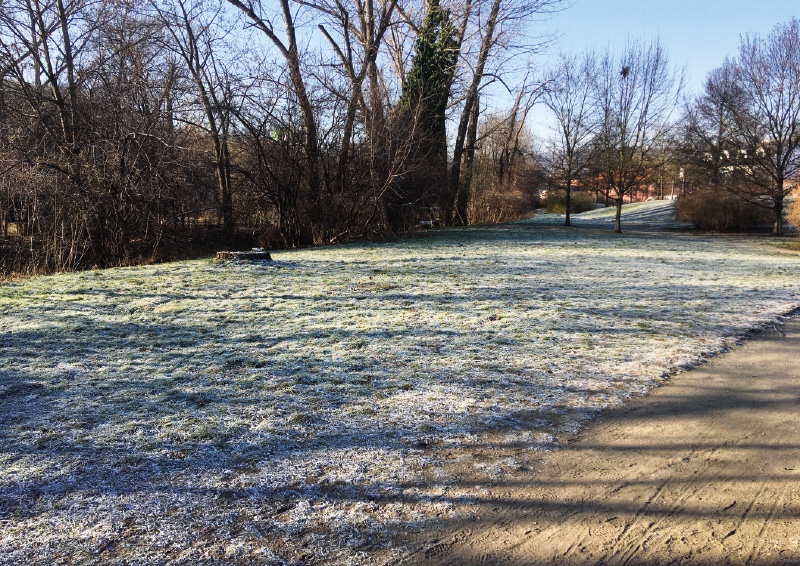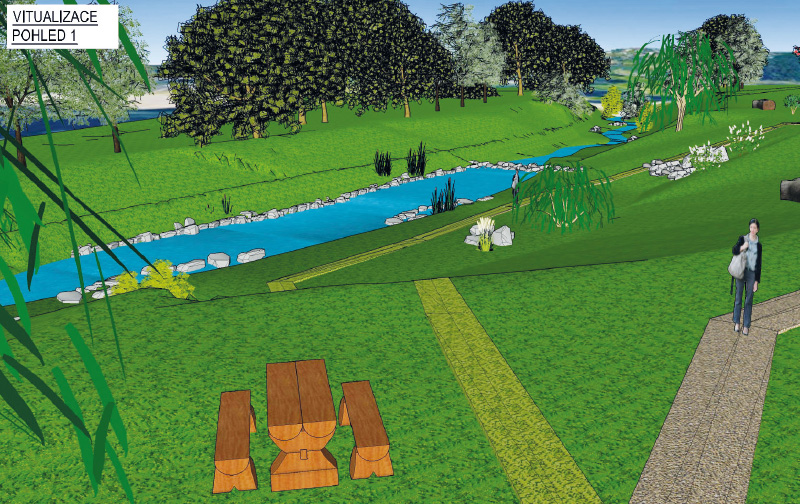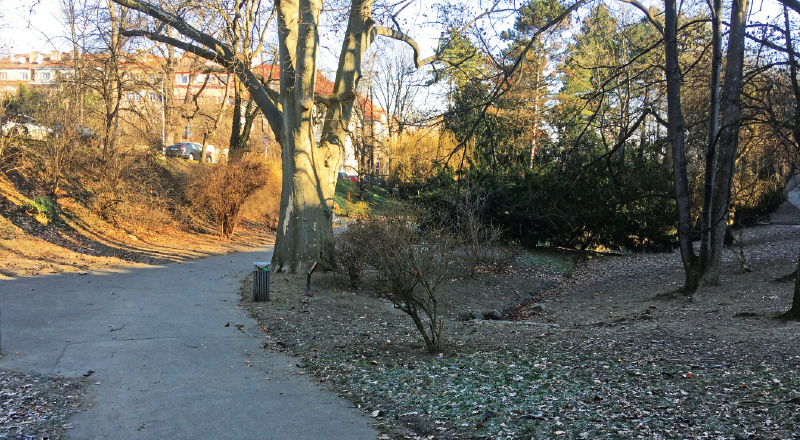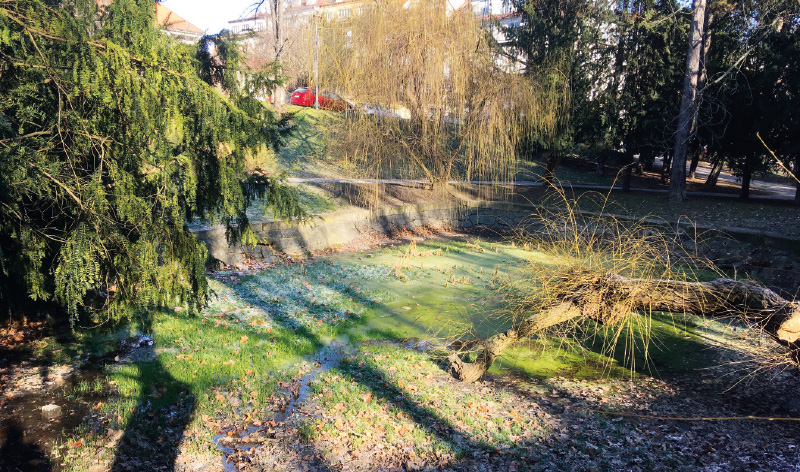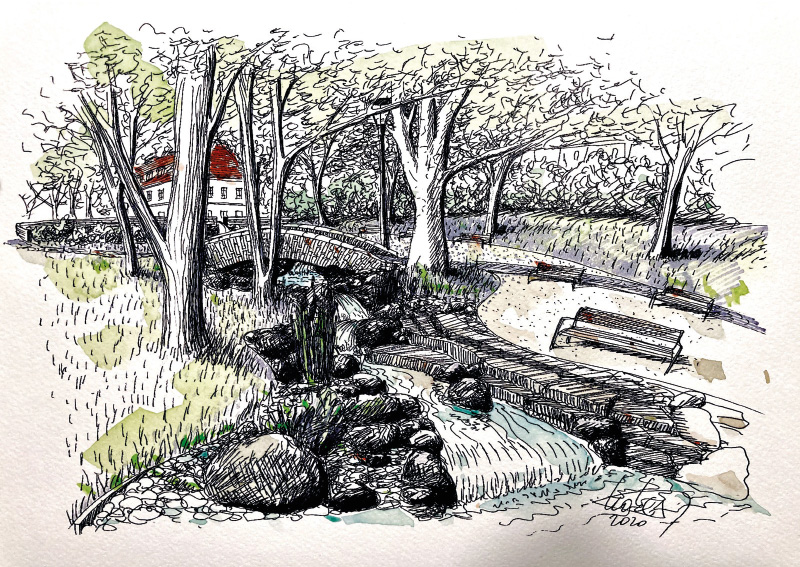Prague 4 district in accordance with the National Action Plan for Adaptation to Climate Change [1], Concept for Protection from the Effects of Drought of the Czech Republic [2], Strategy for Adaptation of the Capital City of Prague to Climate Change [3] and Methodology for Rainwater Management in the City [4, 5], similarly to other progressive-minded parts of Prague, is preparing investment actions to support and strengthen green-blue infrastructure in the city. One of the most visible measures with truly demonstrable effects on the support of biodiversity and water retention in the landscape is the restoration of aquatic ecosystems. In the case of the capital city of Prague and its most populous district of Prague 4, these are mainly the restoration of canalized (straightened or piped) streams, or desilting, strengthening or comprehensive restoration of ponds and small water reservoirs in a highly urbanized landscape. A specific area is newly emerging bodies of water in places where water naturally tends to be retained after longer periods of rainfall and the area thus cannot be used for any other purpose, or even in places where there was no body of water before (although here in the narrower sense of the word it is not restoration). For such areas created by human intervention in order to strengthen the diversity of aquatic and wetland vegetation, the name artificial aquatic biotope has been adopted. Let us have a look at the differences and specific pitfalls of individual restoration using three specific examples.
CONSTRUCTION OF THE BRANÍK AQUATIC BIOTOPE
The idea of an aquatic biotope in Za Mlýnem street in Prague’s Braník district arose from the initiative of the councillor for the environment of Prague 4 district, based on an example of good practice from Prague’s Lysolaje district, where a similar cold-water biotope was put into operation in 2017 (Fig. 1). It was created by rebuilding the already non-functioning fire reservoir on the Lysolajský stream under the so-called “Miraculous spring” (Zázračná studánka) under Housle natural monument, which with a yield of 3.5 l/s is one of the strongest springs in Prague. In contrast to the Lysolaje natural source of water for the biotope, only two solutions were possible in the anthropogenically raised floodplain of the artificially deepened Kunratický stream (Fig. 2): supply the future biotope with a channel/pipeline directly from the stream, or its own water source (well). Due to the highly variable water quality of Kunratický stream, which is affected by overflows from storm water overflow higher up in the basin, it was decided to build an 8 m deep well and to pump groundwater from the floodplain under the Braník structural slope.
The biotope on the artificially lowered terrace will have a free water area of 240 m2 with an average depth of 145 cm, and the maximum depth of 180 cm (Fig. 3). The lake basin will be divided into a deep-water and a littoral zone for planting aquatic and wetland vegetation (Fig. 4). The estimated groundwater abstraction will be 0.3 l/s, with the possibility of its strengthening and regulation with regard to the seasons and maintaining the positive water balance of the biotope. The overflow will be handled via a classic monk sluice with a short, shallow bed with stone steps opening into Kunratický stream. The inflow of water from the well to the biotope is planned on the surface through a system of flat stones in order to ensure the sound effect of running water. Considering the size and depth of the biotope, a year-round low water temperature of up to 16 °C can be expected.
The biotope should gradually become a refuge for psychrophilic species (amphibians, invertebrates), and the natural biocorridor of Kunratický stream should function as a source of these organisms. The aquatic biotope will not be intended for swimming; in addition to its ecological function it will serveas part of the mini educational trail and for educational purposes in the topic of adaptation measures of the capital city of Prague. The immediate surroundings, including the park furniture, will be appropriately landscaped so that the biotope becomes a natural part of Za Mlýnem park.
The total cost of building the biotope, including subsequent vegetation adjustments, will reach around 8 million CZK; running costs (regular cleaning, pump drive, fees for groundwater abstraction) will be paid from the operating budget of the Prague 4 Municipal Council. Completion of the biotope is planned for May of this year. More information about the project can be found on the PinCity website [6].
 Fig. 1. Aquatic biotope in Prague‘s Lysolaje
Fig. 1. Aquatic biotope in Prague‘s Lysolaje
 Fig. 2. Site for Braník aquatic biotope in Za Mlýnem park (view to the east)
Fig. 2. Site for Braník aquatic biotope in Za Mlýnem park (view to the east)
 Fig. 3. Visualization of Braník aquatic biotope (view from the same place as in Fig. 2)
Fig. 3. Visualization of Braník aquatic biotope (view from the same place as in Fig. 2)
 Fig. 4. Status of earthworks as of 1. March 2023 (view to the east, in the foreground is the future lake basin with an already established monk sluice)
Fig. 4. Status of earthworks as of 1. March 2023 (view to the east, in the foreground is the future lake basin with an already established monk sluice)
RESTORATION OF KUNRATICKÝ STREAM
Kunratický stream is a right-hand tributary of the Vltava, flowing through Braník in its lower reaches and creating a valley through which the southern link (Jižní spojka) from Barrandovský bridge leads to north-south motorway (Severojižní magistrála). In its entire lower section, from Kunratický forest to the confluence with the Vltava, Kunratický stream is heavily improved and channelized. The water draining into the straightened narrow, partlially concrete channel does not interact with the groundwater level for most of the year (Fig. 5), which causes very small flows in the dry season. In 2017, the Department of Environmental Protection of the City of Prague decided to restore part of the lower section (approx. 650 m) of Kunratický stream gradually in several stages, taking into account its length. The first of the three parts above Vrbova street was supposed to be implemented in 2021; however, in view of the re-opening of the construction procedure due to the concurrent Braník biotope project, implementation with an expected investment of 25–30 million CZK was postponed until 2024 at the earliest. In the meantime, at least part of the so-called zero phase took place below Vrbova street, consisting of a change in the material and structure of the banks and bottom of the riverbed (Fig. 6), which significantly increased diversification of the riverbed, reduced of water flow velocity and increased the clarifying (self-cleaning) ability of the stream. This year, the second part of the zero phase of restoration of the stream should take place in a similar way, up to its piping below Modřanská street.
As part of the above-mentioned first phase, on the other hand, overall restoration of the stream will be started, including the anthropogenically raised river floodplain of the right bank (Fig. 7), which will be artificially lowered, widened and slope conditions adjusted in such a way as to allow not only future public access to the water, but also creating a floodplain (Fig. 8). Contact with the groundwater level will become possible in the channel made from loose granite blocks, the roughness will be increased, and water outflow velocity will be reduced; together with a smaller artificial pool, this will create a suitable refuge for new species of aquatic fauna, for which the existing channel with fast water outflow is unsuitable (Fig. 5). Due to the limited space given by the complex ownership structure of the land on the banks of the stream, more generous meandering of the riverbed will not be possible, only slight undulation. The newly created floodplain and riverbed will be supplemented with dead wood from trees growing today high above the stream bed. As part of the third phase, a short section of riverbed and floodplain between the existing riverbed and the emerging Braník biotope will be restored in a similar way, so that both structures interact and a synergistic effect is achieved [7].
 Fig. 5. Anthropogenically straightened lower part of Kunratický stream in Braník
Fig. 5. Anthropogenically straightened lower part of Kunratický stream in Braník
 Fig. 6. Restored part of Kunratický stream below Vrbova street
Fig. 6. Restored part of Kunratický stream below Vrbova street
 Fig. 7. Anthropogenically raised floodplain in Za Mlýnem park with an artificially incised Kunratický stream bed intended for restoration (view to the west)
Fig. 7. Anthropogenically raised floodplain in Za Mlýnem park with an artificially incised Kunratický stream bed intended for restoration (view to the west)
 Fig. 8. Visualization of the restored part of the stream and the river floodplain (1st phase, view from the same place as in Fig. 7)
Fig. 8. Visualization of the restored part of the stream and the river floodplain (1st phase, view from the same place as in Fig. 7)
RESTORATION OF THE WATER BODY IN JEZERKA PARK
The vision of the restoration of Jezerka Park in Nusle was presented in a landscape study [8], which emerged from a competition of three architectural proposals, developed on the basis of extensive participation with the public. Due to the size of the park, restoration will take place in several stages; the first stage will involve the restoration of the dried water body (“lake”) and its immediate surroundings, including the restoration of the small watercourse above it, flowing from the drainage below the Na Jezerce theatre (Fig. 9).
The main reason for the pond being non-functional for several years is the total loss of the yield of the source of water due to the progressive climate change and the broken stream bed, through which the remnants of the inflowing water seep into the ground (Fig. 10). In the summer months, the inflow of water into the reservoir usually stops completely. That is why Prague 4 Municipal Council is working on a proposal to collect rainwater from the roofs of the Na Jezerce theatre buildings and to supply the lake (water reservoir) with water through an underground storage tank with an infiltration gallery throughout the year. It is cheaper, and above all, more ecological than the water supply from a borehole or the theatre water supply line that was considered in the original project design. The total area of the theatre roofs is sufficient enough in terms of rainwater runoff so that it covers the annual balance of the water reservoir; therefore, it should have a year-round flow, which will have a fundamental positive effect on the water quality in the reservoir. That is why a camera survey of the drainage and sewerage network around the theatre took place last year, which will have to be restored as part of the project due to its damage and clogging. At present, most of the rainwater from the theatre roofs is drained to the sewer without any further use.
The restoration itself will consist of restoration of the lake basin (the bottom and walls of the reservoir) in the current or only slightly modified layout and, above all, in its deepening in order to improve water quality in the lake (currently, the maximum depth would be only about 1 metre). The banks will be restored, including the possibility to sit on the slopes, but overall the location should appear peaceful, not recreational. The sound effect of burbling water using a system of small artificial dams and the construction of a bridge over the restored small watercourse above the reservoir should also contribute to this sensation (Fig. 11 and 12). At the same time, healthy mature and preserved trees in the vicinity should be preserved, and the area should be sensitively complemented with other wetland and park vegetation with appropriate furniture.
At the moment, the city district has requested a water management assessment for the preparation of project documentation, which will be the subject of a competition in the spring of 2023, and then a joint zoning and construction procedure will be initiated. The Municipal Council of Prague 4 subsequently assumes the inclusion of the investment in the action plan for 2024, so earthworks could start the following year in autumn. Comprehensive restoration should lead to the restoration of the former glory of the lake, which is the centre of the historical park and whose sensitive restoration is also an absolute priority according to the opinion of the citizens in the polls.
 Fig. 9. Today‘s situation of the outlet of the groundwater drainage as an occasional inflow into the water reservoir (downstream view)
Fig. 9. Today‘s situation of the outlet of the groundwater drainage as an occasional inflow into the water reservoir (downstream view)
 Fig. 10. Dried and long-term defunct reservoir in Jezerka Park
Fig. 10. Dried and long-term defunct reservoir in Jezerka Park
 Fig. 11 Visualization of the restoration of the inflow into the reservoir with a bridge and wetland vegetation (view from the same place as in Fig. 9)
Fig. 11 Visualization of the restoration of the inflow into the reservoir with a bridge and wetland vegetation (view from the same place as in Fig. 9)
 Fig. 12 Visualization of the cascading concept of the inlet to the restored reservoir with the sound effect of falling water
Fig. 12 Visualization of the cascading concept of the inlet to the restored reservoir with the sound effect of falling water
This informative article has not been peer-reviewed.


